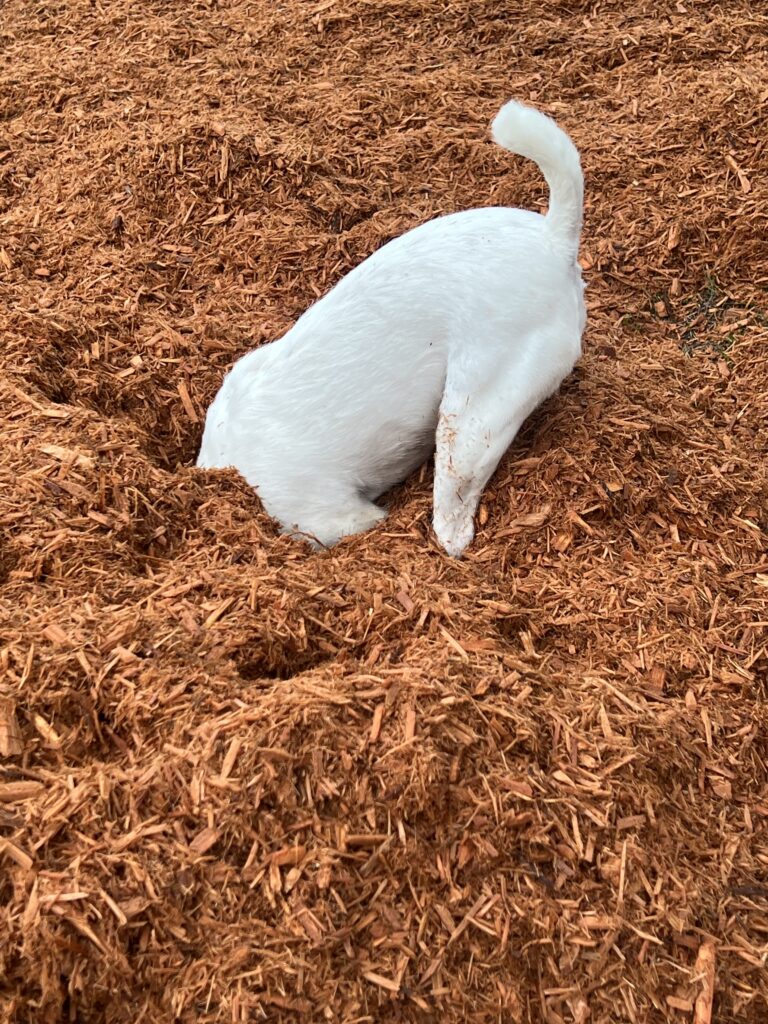
I professionally teach people. I am a dog trainer/trainee with my dogs.
Training is a funny topic. We have to start by asking a deceptively simple question – who is being trained? Ask the average sport dog owner and their focus will be on the training of the dog – regardless of whether they are the one doing the training or outsourcing that work to another person. Start a conversation about training with professional handlers and they will emphasize training the human first, then the dog. Talk to the average companion pet owner and they’ll look at you quizzically as their dog lunges at yet another passerby.
The reality is that both the human and the dog are in a symbiotic training relationship – we are being trained by our dog, while we are training our dog. Training does not happen in isolation or only when we are actively engaged. For better or worse, we are training and being trained every moment of every day. Training is an exchange – behavior offered, behavior acknowledged or ignored, behavior is rewarded or not rewarded. Hint: We are not the only possible source of reward and our dogs are not the only ones being rewarded.
For me, training begins with the human. As a trainer, I hold that the least aversive method be used to teach the human how to be a better handler for their dog. There will be some discomfort, but never anything harsh or overly punitive. A properly trained human is very adept at teaching a dog and even more so with their won dog. Most people only really need help seeing the obvious solution in front of them and a gentle push in the right direction to fix it.
The number one thing I teach most people – keep it simple. Nothing you are trying to do, teach, accomplish is actually that complex or hard. Usually our biggest training challenges have simple solutions. The solution isn’t what trips people up. Focus, discipline and drive are the three things that break on the human side. We lose one or all of those and our training falls apart. Dogs don’t suffer these lapses and so humans end up being taught more by their dogs than is taught to the dog.
For example, loose leash walking. It’s one of the hardest things for people to be successful teaching their dogs. Humans move significantly slower than dogs and generally when the dog pulls the human moves forward. Yep… our dogs teach us to move forward when they pull and then humans can’t understand why their dogs don’t learn to not pull. Want to fix pulling, be prepared to not get anywhere on walks for a little bit.
- Stop going for walks until you’ve taught the foundational concepts. The leash is a boundary. The boundary area can move through space, but only as long as there is no tension on the leash.
- Never initiate the tension on the leash. Your hand and arm should be locked at your side. The leash is not a steering wheel and it definitely isn’t the brake or the accelerator. You do not move if there is tension on the leash.
- The dog should have the full length of the leash you are using regardless of length – 4ft, 6ft, 10ft, 15 ft, etc. Do not loop it over your wrist. Hold the handle in your hand. Want a shorter leash – gather it up and hold it in your hand (DO NOT WRAP OR LOOP). You can then let it go to give more leash.
- As soon as the dog creates tension on the leash, you become a post. Posts don’t have eyes. Posts don’t have mouths. Do not say anything to your dog. Do not look at your dog. Stand perfectly still. They’ll get curious about what’s happened to you and quickly figure out that you have a strange allergy to them pulling on the leash.
- As soon as the dog releases pressure on the leash, stop being a post. Verbally praise your dog. Give a treat or toy as a reward. Start moving. Be prepared to become a post again.
Start this training somewhere easy – the living room, the back yard – control distractions and rewards. Be consistent! Depending on the age of your dog, it’s going to take a minute to undo the pulling training. But most dogs, with consistency, will change their behavior quickly. No public walks until they get the concept, then take it out on the road and keep the rules the same.
This is not the only way to teach loose leash walking. It is one way and it is a fairly easy, straightforward way. This approach can be applied quickly to a lot of situations without a lot of fuss – but won’t work for every situation. Trying to walk your dog to the racing start box? That’s a whole different level and requires some different approaches – including management, unless you are willing to not race your dog until they learn?
Self imposed complexity, ruins teaching.
Dog training is a $28 billion business globally – $850 million in just the US yearly. Part of this is because of the increase in dog ownership and the growing number of dog sports. Another part is the growing number of individuals selling services to train dogs and even people. This industry is completely unregulated and spends a lot of money to convince the dog owner that they are a horrible human being if they don’t take group classes, hire a behaviorist, sign up for every dog sport and have a perfectly behaving dog. Social media further broadcasts the message. There are no standard certifications, managed by a supervising body that will guarantee you the quality of the education you and your dog will receive. There are a few certifications and some governing bodies trying to set standards, but at the end of the day you can only trust your own instincts on whether you are getting a good deal or not.
In addition, you have to wade through the multitude of labels and the stigma around each. Positive only, balanced, old school… each will sell you a spiel about what is at the core of their training, why the others are bad and how your life with your dog will be ruined if you do anything but their special brand of training. Add to that, clubs and event organizers often have additional rules about what is and isn’t allowed – further complicated by lax enforcement and oversight.
I will not go into the good and the bad of all of the various methodologies, systems and tools. I will say that I believe a proper teacher is able to use whatever tools are needed to help a human connect and communicate with their dog and live happily and safely in their world. I would argue that anyone embarrassed by the tools they have to use, probably needs to take a hard look at what they’re doing. Anyone causing pain or significant discomfort to their dog consistently for the purposes of “training” probably needs some help in that area. I believe that in order to understand yes, one must also understand no. Yes doesn’t have to mean a steak dinner and no doesn’t have to mean pain.
The world is a very dangerous and complex place for dogs and humans. Few dogs get to live in the optimal environment and situation for their temperament, energy level and needs. Even dogs that do live in the “perfect” place, face dangers and hazards that sometimes lead to an early demise. On top of that, humans are great at imposing arbitrary and often useless rules – usually caused by that ONE PERSON. We also impose a lot of arbitrary expectations and rules onto our dogs out of our own ego. If you are having to yell at your dog, hit your dog, shock your dog, starve your dog, etc. to get compliance, you need more training and I want to know why you even want a dog. When our dogs aren’t successful, it’s because we didn’t teach them properly. When our dog’s aren’t successful, it’s our fault and our responsibility to fix. The tools and methodology used have zero to do with the dog and everything to do with the human. It is the human’s limitations and skill gaps that require the use of tools and methods. Any trainer that has only one way to train is great if their approach works for you and your dog. The problem is when that trainer convinces you that you and/or your dog are less than because you can’t be successful with their tool or methodology. A good trainer is going to start from where you are and help you get to where you want to be with whatever tools help you and your dog get there.
Focus, Discipline, Drive
When we establish focus, discipline and drive within ourselves, our dogs will follow. It is really that simple. What isn’t always simple is seeing the path before us. A good trainer and teacher will just help you find the path, maybe share a few tools and then send you off to find your way. They’re there to help you find your way if you struggle, but you do the work. Cookie cutter classes, having everyone do the same drills, exercises, etc. They’re fine for what they are, but they aren’t going to teach you to be a better dog person or your dog how to be a better dog. They’re an expensive path to the same destination that others are already working towards. If you are lucky, the person teaching the class will be skillful and helpful. But if your gut and experience are telling you they aren’t, cut your losses and take a different path.
Dog training isn’t rocket science. It isn’t hard. It simply requires focus, discipline and drive. Love is the fuel that keeps moving you forward.
